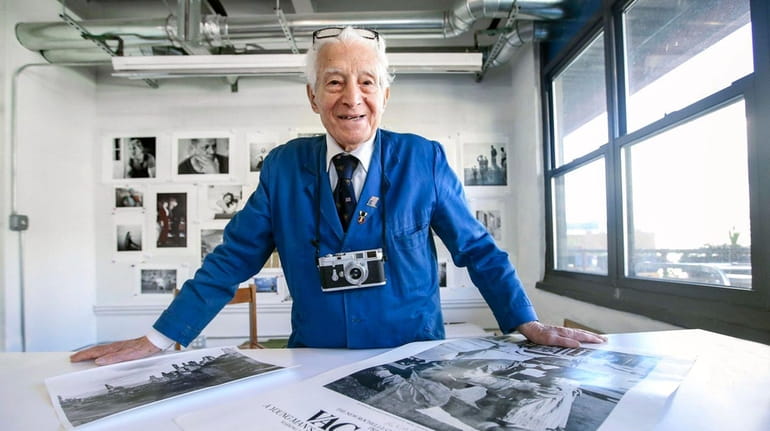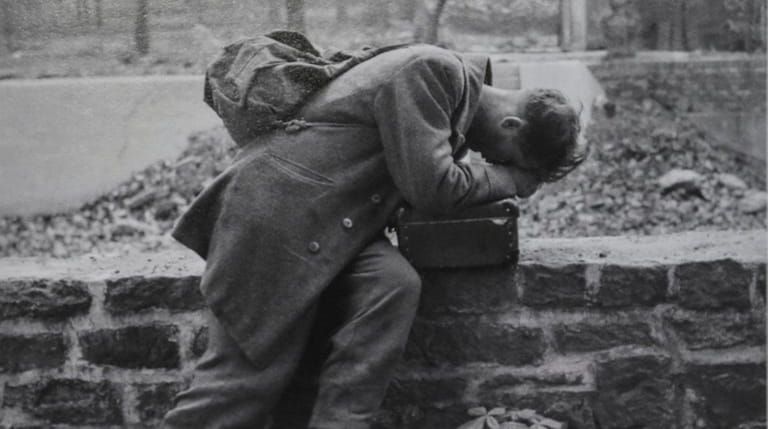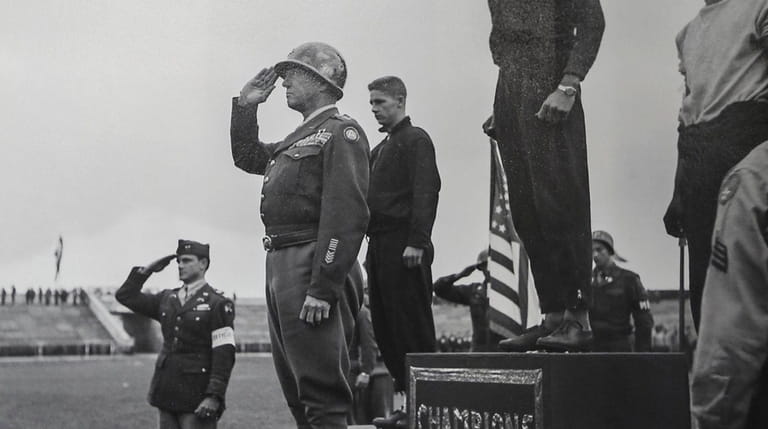At 94, Tony Vaccaro looks back at his brutal images of WWII

Tony Vaccaro, 94, in his Long Island City studio. The World War II vet carried a camera as he stormed the beach at Normandy on D-Day and took numerous photos depicting the horror of the European campaign. Credit: Newsday / John Paraskevas
On June 6, 1944, a 21-year-old U.S. Army infantry scout with the 83rd Infantry Division named Tony Vaccaro was part of the invasion armada on D-Day.
When he finally went ashore, Vaccaro ignored an order barring troops from bringing personal cameras into combat.
America’s cultural and military history have been the better for Vaccaro’s small act of disobedience.
Michaelantonio Celestino Onofrio Vaccaro, “Tony” to everyone, not only survived the invasion but went on to take thousands of personal photographs of the allied campaigns in Normandy and Germany. The images — some haunting and terrifying, others intensely warm and joyous — remain a unique archive of World War II, a body of work that catapulted Vaccaro to global fame and accolades.
Vaccaro, spry at 94, with a head of snow-white hair and a home in Long Island City, said he risked smuggling the camera into combat for a simple reason: “To take pictures.”
His work is on display at Pollock-Krasner House in East Hampton through July 29. Another exhibit at the Gold Coast Arts Center in Great Neck will open on Nov. 8.
Using film and supplies scavenged from bombed out towns, Vaccaro developed his images in foxholes at night, rigging his poncho to cover the pit and helmets to hold the chemicals. Soon, his commanders approved and asked him to take their portraits. He went on to become one of the pre-eminent fashion and lifestyle photographers of his era. Sophia Loren, Pablo Picasso, Jimmy Stewart, and artist Georgia O’Keefe are among the famous he photographed.
Today, Vaccaro still takes photographs and works in his Long Island City studio where his son Frank, daughter in-law Maria, digital editor Manolo Salas and intern Grace Ann Taylor work to preserve and market his estimated 400,000 images.
Iconic is a word that can be easily used to describe much of Vaccaro’s work. The war photos, taken with a vintage Argus C3, show American and German soldiers, as well as French and German civilians, during the final days of the conflict and in the postwar period. One joyous image — a GI kissing a French girl in the city of Saint-Briac-Sur-Mer — led to the street location being named “Tony Vaccaro Plaza.”
Another image, that of a German tank soldier who died in front of Vaccaro, brought him to tears more than 70 years later as he described the man calling out in German for his mother as he died.
“The tank was coming towards me. While it was doing this he was knocked out. The tank stopped,” Vaccaro said as he choked up with emotion. “What was awful was the soldier, dying, burning, still saying ‘Mutter, Mutter.’ ”

A war-time photograph by Tony Vaccaro. Vaccaro, now 93, brought a camera with him when he went off to war in Europe as a GI, and documented much of what he saw, including the horrors of war. After the war, Vaccaro turned to photographing fashion and famous people for publications such as Look and Life magazines. Credit: Tony Vaccaro Studio / Tony Vaccaro
On the dead soldier’s belt buckle, Vaccaro said, were the words “Got Mit Uns,” meaning “God is With Us.” The German words are the title of the photograph.
An image titled “White Death,” ironically launched Vaccaro on his fashion photography career. The shot depicts dead American soldier Henry Tannenbaum, killed in January 1945 and lying face down in a Belgium field, almost completely covered by snow. After taking the photo, Vaccaro cleared the snow and ice to discover it was his Army friend.
“This photo is Tony’s choice of a million options and it is perfect,” said his son Frank Vaccaro. “This is what epitomizes the way Tony chooses the way he takes a photo. It is death, but it is gorgeous.”
Vaccaro said that when noted fashion publisher Fleur Coles saw the White Death image she asked him if he could do the same thing with fashion. Vaccaro said yes and was hired on the spot for Coles’s short-lived magazine Flair.
Fifty years after Tannenbaum’s death, his son Sam contacted Vaccaro. Both men returned to the field in Belgium where Tannenbaum died.

A photograph by Tony Vaccaro shows Gen. George Patton during World War II. Vaccaro, now 93, brought a camera with him when he went off to war in Europe as a GI, and documented much of what he saw, including the horrors of war. After the war, Vaccaro turned to photographing fashion and famous people for publications such as Look and Life magazines. Credit: Tony Vaccaro Studio / Tony Vaccaro
Vaccaro also returned to Normandy for the HBO documentary “Under Fire,” which first aired in November. He visited Omaha Beach, recounting in the film how the stench of death never leaves him.
“The camera helped me to survive,” Vaccaro says in the film.
Today, he stays as active as he can. Widowed [his fashion model wife Anja died at the age of 74 in 2013], Vaccaro dotes after his two grandchildren but carries a camera with him constantly.
About the war? Frank Vaccaro said that the photographs keep the period alive for his father.
“He really felt there would be no more wars after World War II,” Frank said of his father.
CORRECTION: A previous version of this story incorrectly stated the age of Tony Vaccaro on D-Day in June 1944 and the date of American soldier Henry Tannenbaum’s death.

